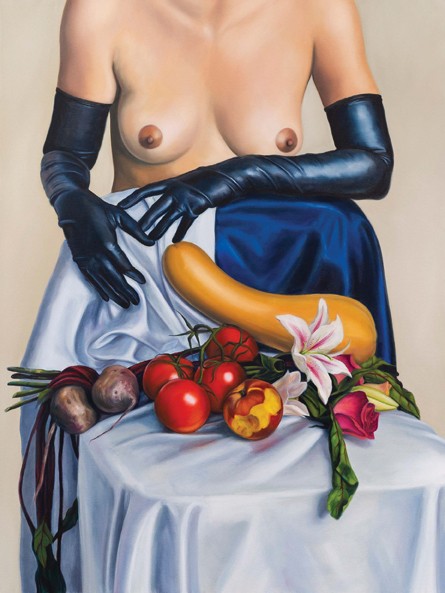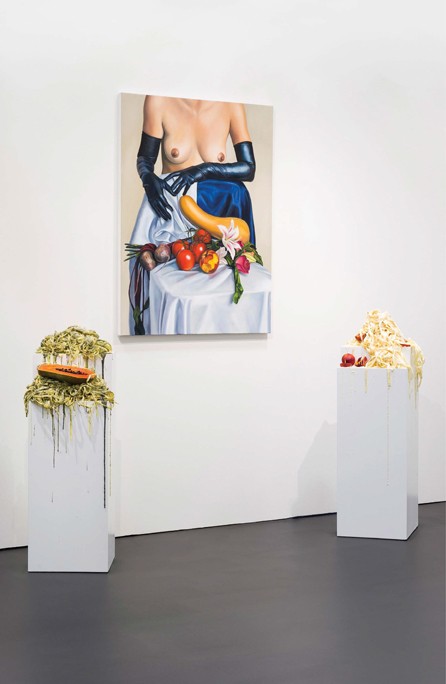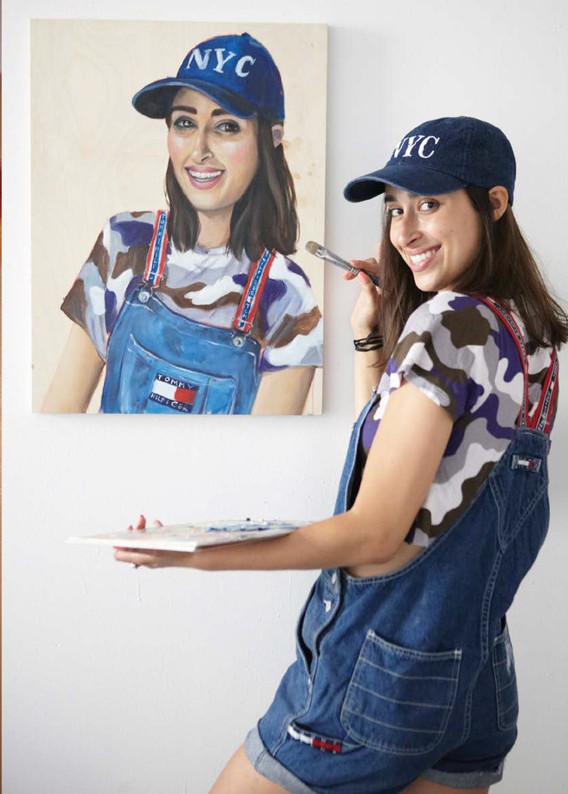Something is Something Else
An Interview with Chloe Wise
Chloe Wise is wise beyond her years. She has hit upon ways to exploit the culture of narcissism and the culture of consumption, and has made her art practice a world where Ashley Madison meets Madison Avenue, all produced in a way that leaves some- body’s tongue in somebody else’s cheek. It cleverly mediates a space between self-awareness and self-indulgence.
Wise came to the attention of the art and fashion worlds when her friend, the model and actress India Menuez, accessorized her Chanel outfit with one of Wise’s bread bags, Bagel No. 5, to attend a dinner party in honour of Karl Lagerfeld. The bag was an oversized bagel sandwich made from oil painted urethane and it became an overnight sensation. Wise has produced other bread bags using the logos of Prada, Fendi, Coach, Dior and Louis Vuitton; her PBJLV is made from eight pieces of bread dolloped with various jams and peanut butter, and her Pancakes No. 5 bag combines 11 overlapping, syrup-slathered pancakes with the interlocking Cs of the Chanel logo. Designer bags have never appeared so sweet.
Wise has also employed a high quotient of humour in playing off her Jewish heritage. Sculptures like a Star of David made from strips of bacon and the Matzochism Cuff Set, which provides a safe way to stay kosher and be chained to Yahweh, may be visual one-liners but they are also irreverently funny. The operative word in the sculptures, and in all the work, is play. Wise and her crew of models, actors and glamouristas are clearly having fun in their video impersonations. The connections they make in Offer Ending Soon! is a complete set of non-sequiturs; impeccably beautiful people lower their heads, look meaningfully and seductively into our eyes, and repeat menu items from The Cheesecake Factory. All style and no substance, it’s as if the snake from the garden of advertising had slipped out of the foliage and left us with only its discarded skin. And what pretty skin it is.

Chloe Wise, Life’s Rough, But Not Rough Enough, 2016, oil on canvas, 36 x 48 inches. All images courtesy the artist, Division Gallery, Toronto/Montreal, and Galerie Sébastien Bertrand, Geneva.
One of the places in which Wise gets to play the most is the sexual sandbox, although what goes on there is more tease than tumult, more insinuation than insemination. Her food sculptures are all splash and splooge, with everything coated in sauces that drip indiscriminately onto their plinths. Certain fruits and vegetables get very messy, so a peach half, already suggestive, is rimmed with a white viscous substance. You have to remind yourself that everything that looks edible in her sculptures is made from painted plastic. Wise’s mimetic chops are sharp and convincingly deployed. In all her media, surfaces are seductive and suspect. “Something is,” she cautions us in a mischievous equivocation, “something else.”
She has said that every photo needs a phallic symbol. In a delicate drawing that could be a self-portrait, the breadwinner cradles a long baguette in her arms; it could be titled A Portrait of the Artist and Her Sex Toy. (It puts you in mind of Robert Mapplethorpe’s iconic 1982 portrait of Louise Bourgeois, in which the then 80-year-old artist impishly tucks under her arm a 23-inch-long, latex- over-plaster cock-and-balls ensemble called Fillette). Wise takes pleasure in references to art history and contemporary art in her work; in O, full of oils is my mind she re-genders Caravaggio’s Boy with a Basket of Fruit; she mise en abymes herself in a Magritte-like diminishing progression on the cover of her new book; her matzoh cuff-and-collar takes its key from Méret Oppenheim; and the faux Eden in her video Feral and wide-eyed in the garden should give set decoration credits to Pierre et Gilles.
All this undisguised poaching is part of the deal; art is no less available to being re-employed than fashion, celebrity or commodity. Everything ends up being grist for the satiric meta-mill. But Wise’s sleight of hand is not slight. Her larger purpose is to inquire into the condition of misogyny and to use women, and the manner in which they are represented, as both subject and object. She reasons that if you’re going to criticize women for how they regard themselves, then she will obsessively provide you with material evidence of that self-regard. Her description of her “unlearned” self-portrait paintings is generally applicable to her work; they were “super self-involved and obsessive.” Wise’s achievement is to push that self-involvement outside of itself and into the desired and desiring worlds of art and fashion where its motivations and effects can more easily be scrutinized.

Installation view, 2016, NADA, New York. Photo: Paula Abreu Pita.
Chloe Wise’s “Horrible Sound As Well” was on exhibition at Division Gallery in Toronto from January 28 to March 4, 2017. She will show with Jeffrey Deitch at the 2017 Armory Show in New York in March and with Galerie Almine Rech in Paris this September.
The following interview was conducted by phone to the artist’s Brooklyn studio on Friday, January 20, 2017.
Border Crossings: You paint and draw, you make sculptures, design installations and do videos. I gather inside your practice there is no hierarchy.
Chloe Wise: My interdisciplinary approach to art-making means I see art as one big blurry mess of media, where each medium is inextricable from the next. Everything I do informs every other thing, so for me there is no hierarchy. I don’t separate them in my mind.
When you get an idea how do you determine what form it will take?
I think in the form. I’m a literal person and a very representational thinker. While they may have some abstract thought processes behind them, my ideas are always in a finished product. I know when I want to make a painting or when I think of a scene for a video, but at the same time there is a lot of overlap. As we speak I’m drawing a friend, but that friend is also in my video and she is holding food that looks like something I sculpted, so there’s an ongoing relationship among my different art practices.
**Do you tend primarily to use friends—and occasionally family—as subjects for your paintings, drawings and videos? **
Usually it’s people I’m pretty close with and occasionally, someone whom I think is very beautiful or interesting looking or funny or inspiring. That can be reason enough to incorporate them into my work. But for the most part it is people in my circle.
I’m interested in the series where you photograph yourself posing in front of the self-portraits you have already painted. What gave you the idea for that particular body of paintings?
I can trace the idea back to the summer I moved here. I had taken a lot of figurative painting courses in Canada and learned an academic way of working. When I moved to New York I had this weird feeling that there was something inconsequential to all that I had learned. It didn’t feel as if it were a means to make a statement or express my feelings or the concepts I wanted to explore. Painting traditional portraits didn’t correspond to what I was thinking about or going through. I wanted to unlearn that form of painting by doing anti-paintings. So I did the opposite of what I had been taught. I did these really fast paintings that were super self-involved and obsessive. The word that year was “selfie” and what was annoying was how much women, and their self-representation through the use of selfies, was being talked and written about. So the paintings are a satire of how people see me and how people see women who represent themselves. People tried to call me a selfie artist and I thought, Why? I do sculpture and traditional oil paintings of myself and other people. But I ended up doing a bunch of them because it was so much fun to unlearn painting.
.ChloeWise_11_72_566_794_90.jpg)
I Found God At Sunglass Hut, charcoal on paper.
Do you still have the paintings?
That was a difficult thing to figure out because I initially thought they should only exist in the photo that I took of myself after I had made the painting. It was a way of pushing this overtly narcissistic, over-the-top performance even further. So I took these photos and I made a zine and that was to be the finished piece. At that point I didn’t have an art career but when that started to happen people wanted those paintings. My gallery sold a few of them and they were sold with the understanding that if I wanted to have an exhibition I would always be able to get them back. I also painted over some of them because I felt they weren’t finished. So it was a weird, not really thought-through performative event.

“Literally Me” series, 2014, c-print.
You have said that one of the things you want to do is to investigate what constitutes an act of narcissism.
I was interested in it because of its connection to misogyny. Narcissism is a pejorative word that tends to be gendered. Women are supposed to be humble, shy, tame and domesticated, and narcissism is seen as this over-the-top pride that makes them untrustworthy. A lot of words carry a gendered stigma, so my work investigates the misogynistic parts of everyday life and how we talk about or perceive women.
Your videos are populated with beautiful creatures of every gender and every sexual inclination.
Part of it is because I am surrounded by people who don’t adhere to a binary. My friends identify in whatever way they want. Casting the way I do is not a question of intention as much as representing what’s around me. So I use classic, almost canonical ideas of normalized beauty, but on the other hand I like to provide inconsistencies. My video called Feral and wide-eyed in the garden has a cast of diverse people playing roles based on Adam and Eve. The characters are beautiful and understandable as Adam and Eve but the “natural” beauty is in quotation marks. It’s an airbrushed, unnatural and fake garden. I’m interested in these dissonant realities. When we see beauty we want to be able to quantify, domesticate, understand and protect it, but we also want to violate it. I have always had a really bizarre relationship with beauty.
…to continue reading the interview, order your copy of the issue here, or save big and subscribe today….

